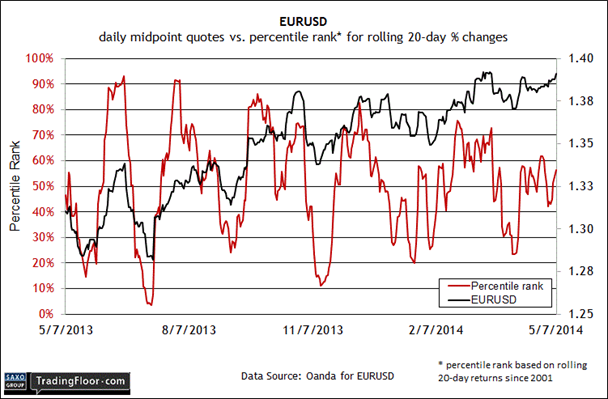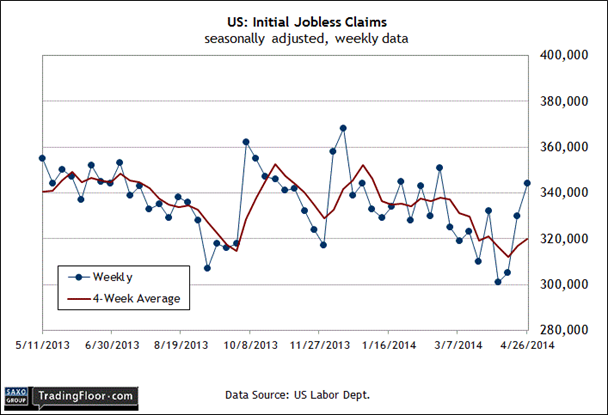Thursday is a busy day for economic releases, including statements from the Bank of England and the European Central Bank. The markets will also pay close attention to today’s jobless claims report for the US for deciding if last week’s unexpected surge in unemployment filings is a sign of trouble or just a temporary bout of volatility.
Bank of England Monetary Policy Announcement (11:00 GMT): It’s all about housing today, and what—if anything—the central bank plans to do or say about it. Some have already picked up the habit of calling the UK real estate boom a bubble, and offered equal stark policy prescriptions. The Bank of England (BoE) “may yet need to go nuclear to burst the housing bubble,” The Guardian recommended. The OECD also warned that the residential real estate market in Britain is becoming a bit frothy.
Perhaps, but no one sees a change in interest rates today. The BoE’s policy rate of 0.5 percent is widely expected to stand after today’s policy news. Prudent or not, keeping rates low contrast with the strong price increases in housing. According to the Nationwide House Price Index, UK prices jumped 10.9 percent on the year through April—the most in nearly seven years and the first double-digit increase since 2010.
The fact that economic momentum generally remains positive for the UK suggests to some analysts that the time is ripe to begin the job of reducing the liquidity stimulus. But the advice will fall on deaf ears today. The BoE is comfortable with letting its stimulus policy continue as is for at least three reasons. One, inflation is now below the central bank’s two-percent target. Two, the recovery has only recently been posting convincing signs of growth. Three, BoE Governor Mark Carney has recently gone on record (again) stating that it’s still too early to start hiking rates. “We are one year into a recovery, but it is an uneven recovery,” he said last month. “Our job is to help turn this into a strong, sustainable and balanced expansion.” For the moment, that still means erring on the side of letting the economy run a bit hotter for longer.
European Central Bank Policy Announcement (11:45 GMT): Like the BoE, the ECB is widely expected to let its current policy rate stand. Europe's central bank is also receiving lots of unsolicited advice to act. But that’s where the paths divide. Whereas there’s a growing chorus of policy wonks recommending that the BoE begin raising rates, the opposite prescription is directed at the ECB. Deflation is still a risk, which prompts The Economist to write: “Please ease” this week.
It’s not going to happen, at least not today, according to the consensus forecast. The 0.25 percent policy rate will be with us a while longer. But the OECD thinks it’s time to do more. “Disinflationary pressures are now strongest in the euro area,” the think-tank observed in its new economic outlook. Headline inflation is “well below the ECB objective of a rate close to two percent and the annual rate of core inflation declined by around ¾ percentage point over the year to March, to just 0.7 per cent, before rising back to an estimated one percent in April.”
Although the ECB isn’t likely to be persuaded to roll out an aggressive new stimulus programme, the recent economic news has been modestly encouraging to the point that it offers the bank some leeway to argue that it can continue to wait and hope. Inflation’s a bit higher (although still unusually low) and growth’s a bit stronger, and so June is now the best guess as the start of any change in monetary policy. But much depends on how the numbers look between now and then, including the trend in the euro, which continues to strengthen.
In other words, waiting and watching has a price these days. A stronger euro is increasingly squeezing the Eurozone economy by making exports less competitive. Indeed, ECB President Mario Draghi has recently said that a stronger currency at some point would probably trigger asset purchases. “The main problem for the ECB is if they don’t do anything,” a UBS currency strategist told Bloomberg yesterday. “Then I would think we’d break the highs of the year, which will mean more pressure for them later on. If we do go above USD 1.40 it would create a lot of headlines that they could do without.”

US Initial Jobless Claims (12:30 GMT): Last week’s disappointing report on new filings for unemployment benefits threw cold water on the recovery party. Although the unexpected surge in claims to 344,000 for the week through April 26 looks like an anomaly, we’ll have a better sense of how to think about this leading indicator after reading today’s release.
The latest pop in claims would be worrisome if it reflected the general trend in economic news. It doesn’t. Most of the recent data updates for March look encouraging for anticipating a faster rate of growth in the spring. Until last week, that was also the implied forecast in jobless claims, which dropped to a seven-year low in early April. Is the data now telling us something else? Unlikely, at least for now. Claims are quite volatile in the short run and so we’ll need to see several more discouraging reports to argue that this data set is now projecting a darker future. But the risk of another round of bad news looks minimal for the data du jour, according to the wisdom of the crowd. Claims are expected to post a modest retreat to 330,000 in today’s release, down from 344,000 in the previous week.
That’s enough to drum up a fresh round of support for thinking that the labour market is still growing. Then again, this would be an unusually awkward moment for another upside surprise. Claims are currently at the highest level since February, and so a fair amount the recent improvement in the macro outlook is hanging in the balance with today’s update.

